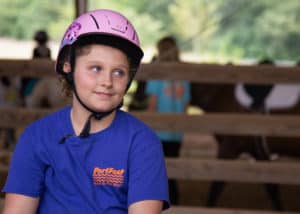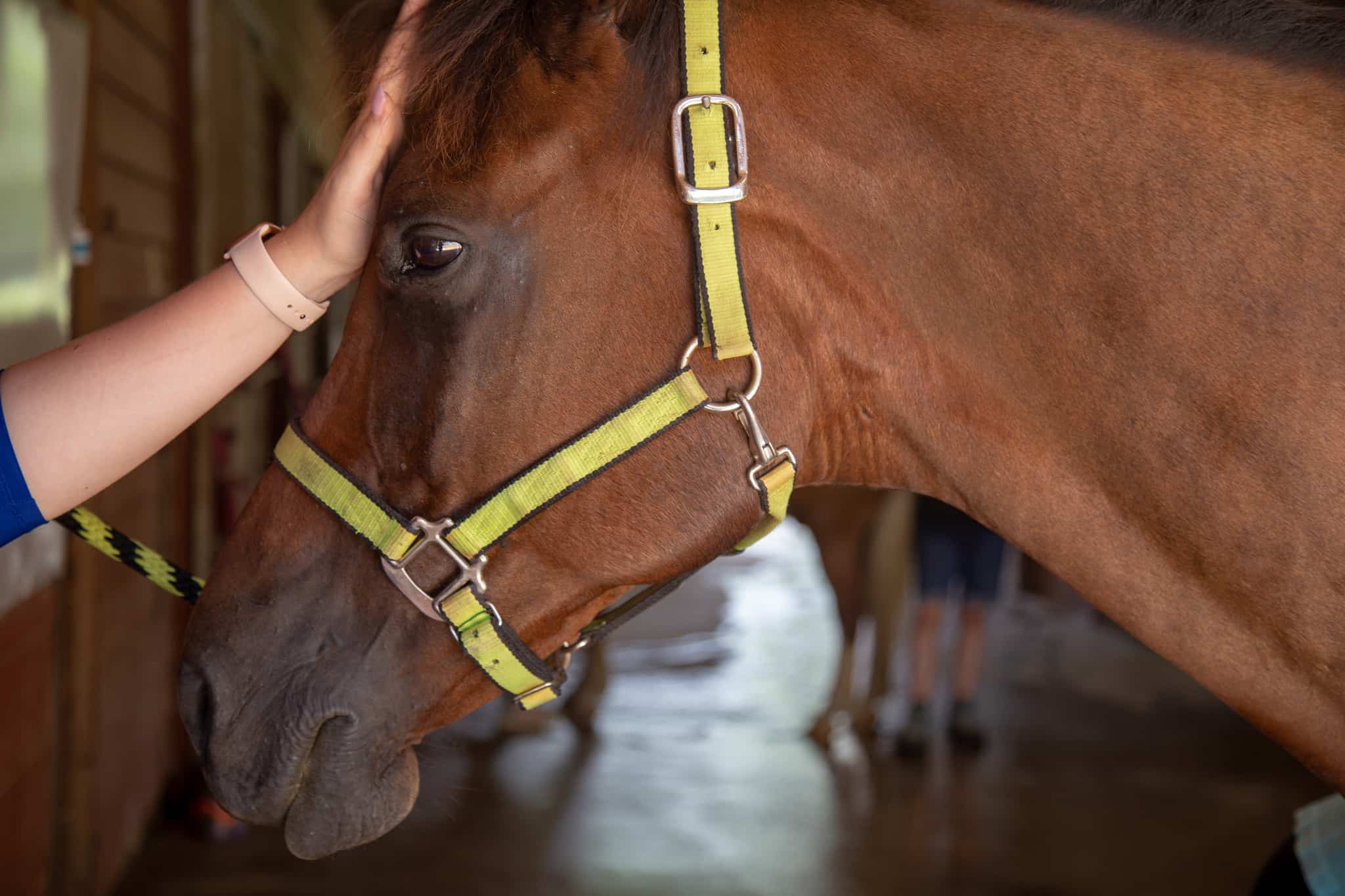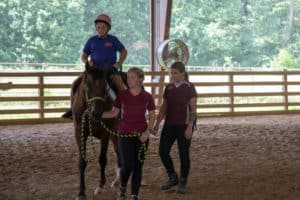Horse Riding Therapy Ensures Smiles for STRIVE Students
| On a hot July afternoon in Sherwood, three horseback-mounted children are excited to begin a therapy session at Hearts & Hooves.
The students have been showing up faithfully to the ranch for their weekly sessions during the summer thanks to a grant awarded to the organization. Children in the UAMS Psychiatric Research Institute school-based therapy program called STRIVE were able to take advantage of the opportunity
“Horses are my favorite animal,” said 10-year-old Kayleigh Myers. “They’re calming and fun to ride. I feel brave when I’m up there.”

Kayleigh Myers was happy to learn equine-facilitated learning would be a part of her therapy this summer.
Hearts & Hooves is a non-profit therapeutic riding center that offers a variety of services including equine-facilitated learning.
“We work with children who are behaviorally challenged,” said Jean Doss, a licensed clinical social worker and program manager in the UAMS Psychiatric Research Institute. “Some of them have a lot to cope with, and some have trouble with anger management.”
The therapy offered by Hearts & Hooves helps the students learn how to address internal struggles through their interaction with the horses. Executive director Michele Easter says it usually doesn’t take the students long in their session to relax once they’re on their horses in the arena.
“Horses are great mirrors for whatever energy we’re putting out there,” Easter said. “So many kids – and adults, too – stay in a state of stress and forget how to relax. We challenge the students by using the horse.”
The horses give clues, Easter said. If it is looking around or yawning, that is a sign the horse is reflecting the stress of its rider. The goal is to get the horse to drop his head and start making licking and chewing motions with his mouth.
“While the students focus on trying to relax the animal, they’re also relaxing themselves.”
The sessions begin with a series of exercises that prepare the clients for controlling the horse.
“We give the exercises fun names like ‘super girl arms,’ or ‘reach for the sky,”’ Easter said. “We’re trying to show them they don’t have to hold on so tightly to the reins. They just have to maintain balance.”
Balance is key to riding a horse, and it takes concentration. The concentration helps the student to practice being present in the moment.
“You can’t think about the grocery list or how someone upset you earlier in the day when you’re on a horse,” Easter said.
Riding is also a good physical activity, improving flexibility and muscle strength. Easter says horseback riding uses the same muscles as walking.
“Your body has to be engaged in order to stay in place on the horse. First-time riders often say they have aches in muscles they didn’t know they had.”
In addition to learning about equine behavior and riding skills, the students learn basic horse safety and grooming.
Kayleigh was very excited when she found out equine-facilitated learning would be a part of her therapy this summer.
“I couldn’t wait.”

UAMS mental health professional Matthew DeSalvo watches his clients during a session at Hearts & Hooves.
Her grandmother, Melissa Catlett, says the therapy has made a difference in Kayleigh’s behavior.
“She’s learned a lot about horses and their demeanor. It has really helped her through challenging situations. We’re very fortunate to have this experience,” Catlett said.
Kayleigh’s experience is not unlike others who have gone to Hearts & Hooves through the STRIVE program. Doss says one boy who hardly spoke at all during sessions with a therapist started smiling more during his first visit to the arena. By the second visit, he was talking more and a smile never left his face. He was also moving around more confidently.
UAMS mental health professional Matthew DeSalvo says each of his clients look forward to going to the ranch each week.
“It’s been fun to watch the smiles on their faces,” he said. “You can see they’re enjoying life. Plus, it gives them an opportunity they may not have otherwise had. And they’re learning bigger lessons about control and relaxation.”
DeSalvo says many of the students can’t wait to be able to trot or gallop on their horse. But that comes with lots of practice.
“You have to be able to show us you can stop and turn your horse in order to trot,” Easter said. “They love to get to that point. There’s never a non-smiling kid when they’re trotting.”
Doss says she’s working to continue the partnership into the fall.

